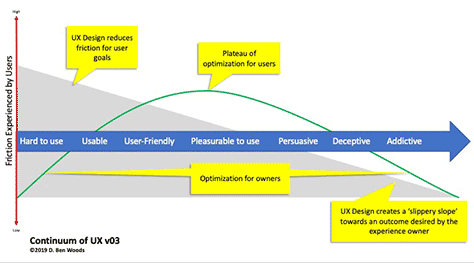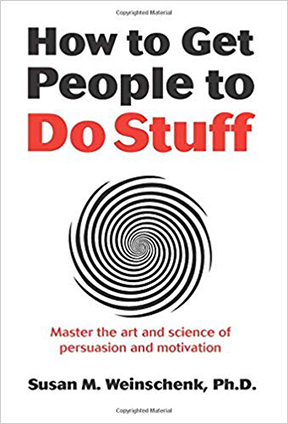
Book Specifications
Title: How to Get People to Do Stuff: Master the Art and Science of Persuasion and Motivation
Author: Susan Weinschenk
Formats: Paperback, Audiobook, Kindle, MP3 CD
Publisher: New Riders
Published: March 21, 2013, First edition<
Pages: 216
ISBN-13: 978-0321884503
From Persuasion to Manipulation
Empathy with users is central to UX design. As UX professionals, we incorporate empathy and user-centered thinking into our design processes, which we ultimately intend to serve the needs and goals of users. While we can easily see that this approach should be well received by product-development teams—whether creating a Web application, mobile app, or physical product—many UX professionals work in marketing departments that have responsibility for conversions. Such conversion-centric organizations apply User Experience to further the goals of marketing and persuade prospective customers to perform an action their organization wants.
In these environments, UX professionals may find themselves advocating for the customer in ways that are not aligned with the goals of their marketing colleagues. However, by understanding the research behind persuasion, these UX professionals can advance the needs of their organizations through their skills.
Weinschenk’s Approach
Evil by Design organizes methods that nudge users toward a particular goal that the owner of an experience has defined around seven deadly sins. Coincidentally, in How to Get People to Do Stuff, Susan Weinschenk also organizes her methods into seven drives, or deep-seated motivations, that influence users’ behavior. These include social motivations such as wanting to belong, positive and negative reinforcement, instinct, and others.
Weinschenk presents the psychological basis for many of our behaviors and attitudes, explaining in an accessible manner how our physiology and psychology affect and control us. As Weinschenk explains, it is well understood that team-building exercises or encouraging people to work and play together, even recreationally, engenders a positive feeling among them and bonds them together, strengthening the ties that create a high-performing team. While we might attribute their performance to shared goals or familiarity, we can also identify a specific hormone—oxytocin—that is released when people work together or bond by performing activities together. Following her explanation of this concept, Weinschenk offers a brief summation and describes how to apply this concept. For example:
“Strategy 11: To get people to do something, first bond them together as a group with some kind of laughter or synchronous behavior.”
 Susan Weinschenk is known for her psychological approach to User Experience. She holds a PhD in Psychology, worked with Human Factors International, and created a following by portraying User Experience through the lens of brain science. Weinschenk is a well-known speaker and the author of several books that discuss the application of psychology to User Experience, including How to Get People to Do Stuff: Master the Art and Science of Persuasion and Motivation.
Susan Weinschenk is known for her psychological approach to User Experience. She holds a PhD in Psychology, worked with Human Factors International, and created a following by portraying User Experience through the lens of brain science. Weinschenk is a well-known speaker and the author of several books that discuss the application of psychology to User Experience, including How to Get People to Do Stuff: Master the Art and Science of Persuasion and Motivation.